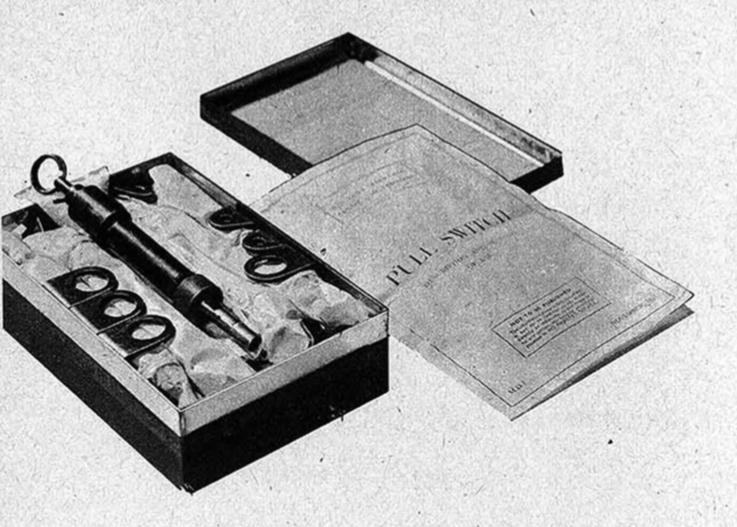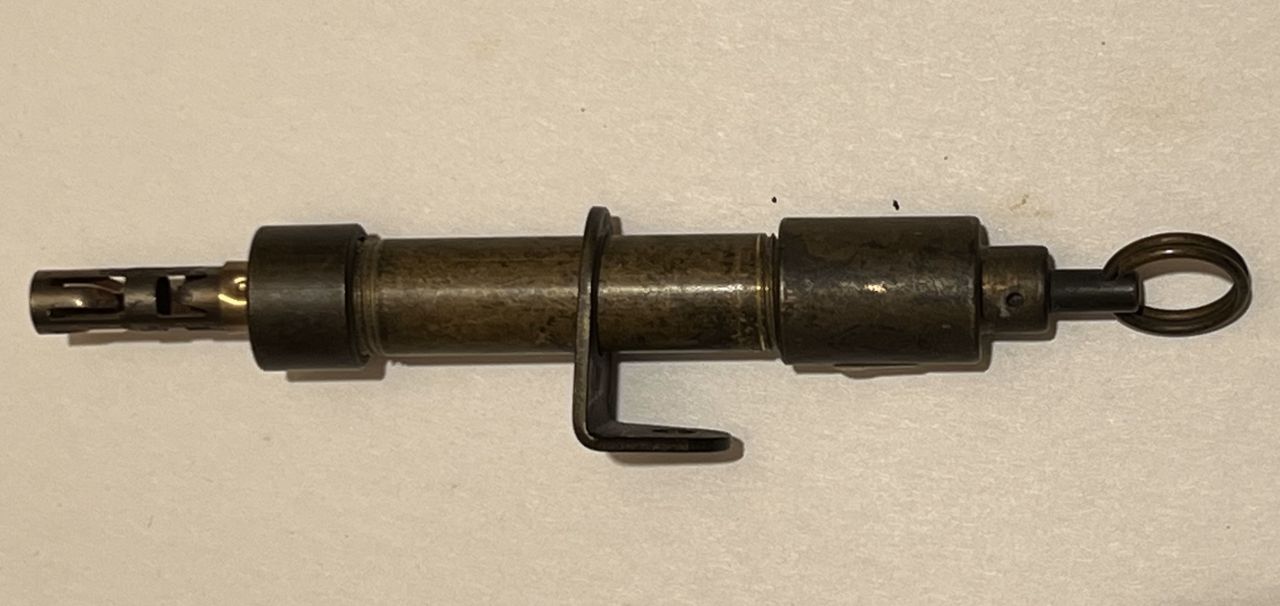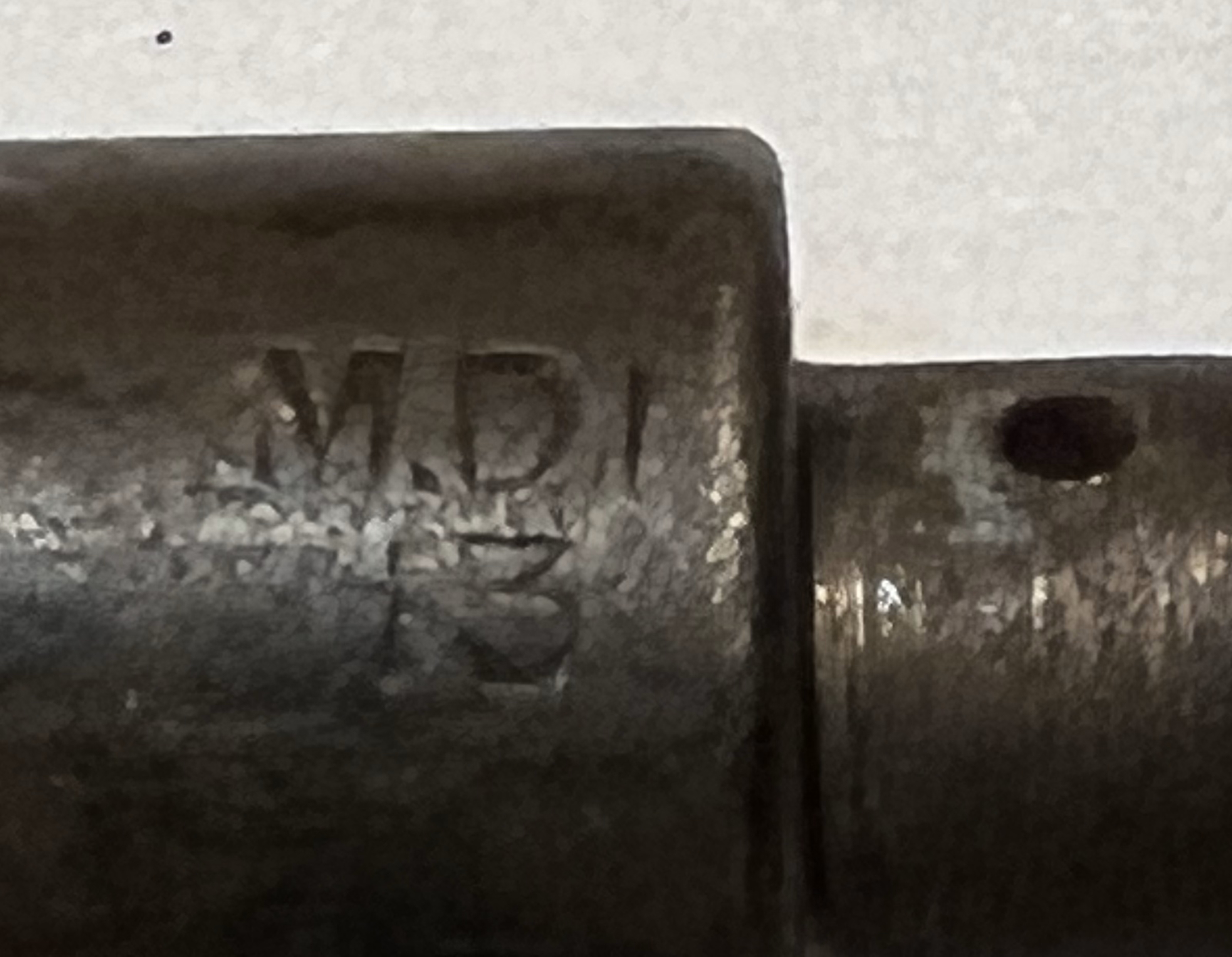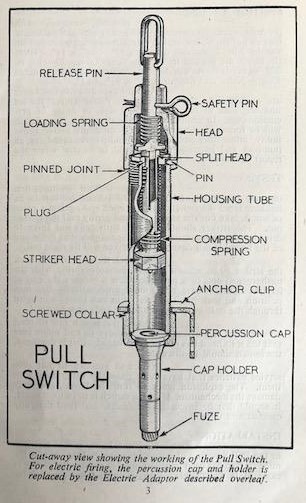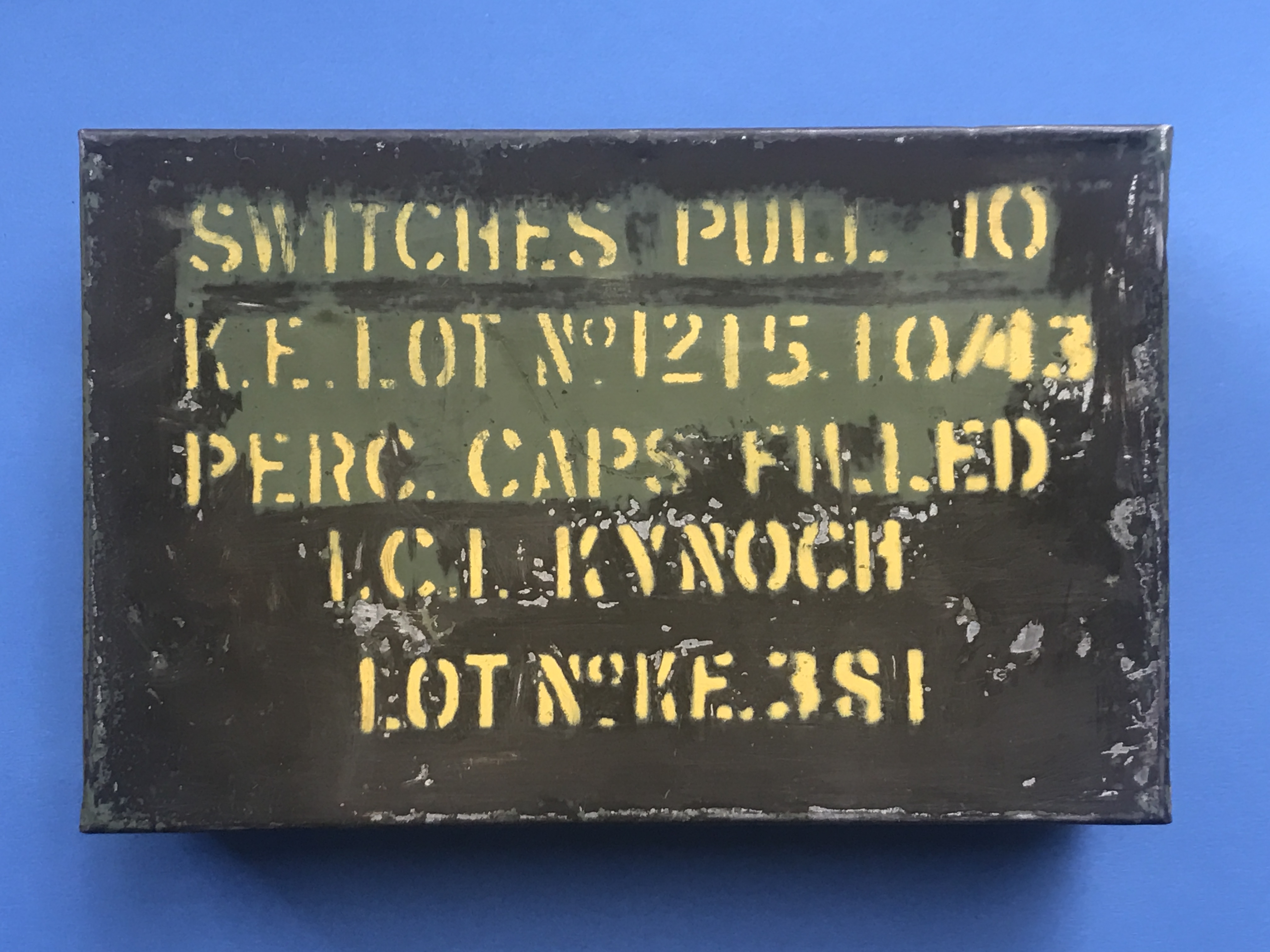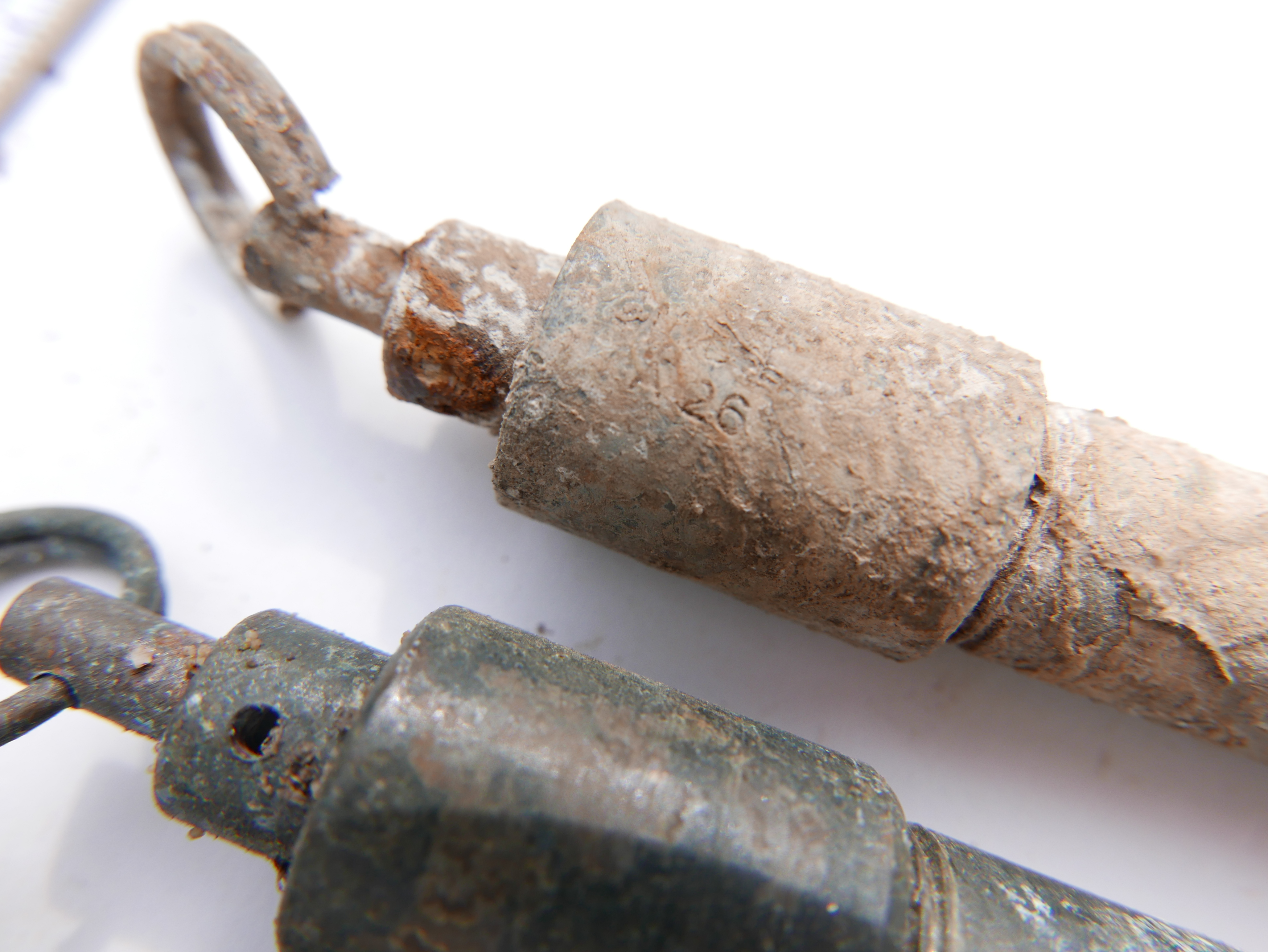Pull Switch
Later known as the Switch Number 1 Mark 1.
Development
The Pull Switch was designed by Stuart Macrae from MD1, the specialist weapons research and design centre also known as “Winston Churchill’s Toyshop”. It was reportedly first conceived in September 1939, with a prototype being made the next day by Francis Alexander Thomassin of the Kinematograph Engineering Co. It used the same diameter barrel as the recently designed Pressure Switch, with the same screw cap holding the percussion cap and detonator holder in place. The internal mechanism design was based on a shirt collar stud worn by Stuart Macrae (in an era where short collars were detachable and had to be held on by studs). This had a detachable head with a split tube attached, that was locked in place by a pin and opening on the body of stud. The drawings were completed in an hour and the design was so successful that no further modification was required. Within a fortnight the switch was in production
Macrae’s Diary for 22nd December 1939 recorded attempts to rapidly get together supplies for the Finnish Army fighting the USSR. Pull Switches were unavailable as Hulberd Patents Limited, who were manufacturing them, were held up for want of the right springs. By the end of a year an order for an additional 500 Pull Switches would be placed. Over the course of the war, 2,805,650 would be made, at a cost of 2 shillings and sixpence each. From January 1941 it would be added to the list of approved War Office devices as part of the Ordnance Vocabulary.
Construction
The Pull Switch was largely made of turned brass. The central barrel was threaded at both ends. A cap with central hole was attached at one end to retain a detonator holder. The other had a larger diameter brass assembly screwed on that included the release pin, secured by a steel split pin. The firing pin was under tension from a long spring. Pulling on the release pin with around 4 pounds of pressure released the firing pin against the percussion cap. The percussion cap contents were pink, but if they turned brown the caps were damp and needed to be replaced. Auxiliary Units were recommended to store the removed caps in glass jars (Kilner type) and were provided with replacement percussion caps for training. The Pull Switch was very durable and could be reused after being fired in training by resetting the spring and replacing the detonator holder with a new percussion cap. The switches were chemically treated which resulted in a dark green finish to the brass. They were not painted.
The main cylinder was ½ ” (1.25 cm) diameter and the cap and release pin section 5/8” (1.6 cm). The overall length was 4” (10 cm). The release pin was held in place by a steel split pin. A brass ring allowed through a hole in the end of the pin allowed a trip wire to be easily attached. The earliest switches appear to have a slightly different, bell shaped, housing for the release pin. On the later production this is cylindrical. Pull Switches are marked MD1 and an additional code A4, A13, A14, A26 and A33 have all been noted.
Manufacturers
At least five manufacturers were involved. Hulberd Patents Ltd (HP), Kinematograph Engineering Limited (KE), Joseph Lucas (L) and two unknown with letter codes O and DC. For the percussion caps (and presumably the associated detonator holders), there were additional manufacturers. Known letter codes are BH, CA, DC, EA, KE and LP. The Lot numbers appear to have been allocated in blocks, but used in date sequence by each manufacturer from their allocation. The highest known switch Lot number is 1215.
Packaging
The earliest issues of Pull Switches were provided in unmarked wooden boxes. These contained 50 switches contained within a single tinplate liner. The lid was nailed down and wire wrapped at each end.
From March 1942, tinned steel boxes, painted dark green, containing 10 Pull Switches were in use. They measured 5.5” x 3.5” x 1.5” (14 x 9 x 4 cm) with a 0.5” (1.25 cm) deep lid made from folded tinned sheet soldered at the corners. Inside the switches were wrapped in waxed paper. The tins were sealed with adhesive tape. A full tin weighed 2lb 2oz. Possibly the change was to improve damp resistance compared to the wooden boxes after opening. The box contained a printed leaflet with instructions for use and a packing slip. The leaflet dated from at least November 1941, suggesting they may have come with the earlier box type as well. These were stencilled in 3/8” (1 cm) yellow paint script:
SWITCHES PULL 10
* LOT No xxxx DD/YY
PERC. CAPS FILLED
I.C.I. KYNOCH
LOT No. xxxx
* denotes where the manufacturers letter code would be stencilled. The Lot number and date were normally stencilled on as well, though hand painted and stamped examples exist.
20 tins were packed in a wooden crate for transit. This measured 14” x 9” x 9” (approx 35 cm x 23 cm x 23 cm). The box was marked with the same details as the tins. A full box weighed 52 pounds (approx. 24 kg). The tins inside were stacked 2 x 2 x 5.
From October 1943 they were called Switches No. 1 and the stencilling changed accordingly. A few tins from this month have the original named overpainted with the new one. No tins dated after November 1943 have been identified. Either the packaging changed again, or the Switch was no longer being produced with new alternatives available. Other switches are know to have been issued in tins with paper labels, but no confirmed examples are know for the Pull Switch tin, though a couple have been seen that may have the remains of a paper label.
Electric Adapters
These were produced to allow the Pull Switch to be used for electric firing. The adpater replaced the percussion cap and when fired, the striker caused two contacts to be closed, completing an electrical circuit. These were issued in tin boxes of 50, of similar design to those for the switches, but different dimensions, measuring 5” x 3” x 2.5” (approx 12.5 x 7.5 x 6.5 cm). These were packed for transit in wooden boxes holding 10 tins, measuring 18” x 6.25” x 6.25” (45 x 16 x 16 cm). The tins were stencilled in 5/16” (0.8 cm) yellow paint script:
50 ADAPTERS ELECTRIC
(FOR SWITCHES PULL
& PRESSURE)
* Lot. No. xxxx MM/YY
Auxiliary Units
Pull Switches were not part of the initial Section D Dumps. The first issues appear to have been separate to the Aux Units packs and records note 50 Pull Switches issued to a Patrol in a single box. In May 1942 any remaining issue in wooden boxes were to be exchanged for the newer production. The Aux Units Mark II packs initially contained 12 Pull Switches in December 1942, but by July 1944 this had been reduced to 6. This suggests the packs did not contain the normal full tins. A number of tins survived in the hands of Auxiliers, suggesting that perhaps they did receive the tins. In June 1943 orders were issued to ensure that Patrols did not hold more than 50 Pull Switches above the contents of the Mk II packs.
Pull Switches were also issued to Intelligence Officer’s headquarters. The Scale of Issue refers to 50 switches, suggesting a single wooden box. They are also believed to have been utilised by Scout Sections, though no direct evidence has been identified to date.
Auxiliary Units do not appear to have made use of the Electric adapters.
Special Operations Executive
Pull Switches were used by various branches of SOE. The Small Scale Raiding Force included these among reports of equipment used on missions. SOE training manuals included Pull Switches in early editions. They are believed to have been dropped into France. Later in the war they were replaced with the smaller No.4 Switch which had the same function, but used less material and was significantly lighter.
Winston Churchill’s Toyshop, Stuart Macrae, 1971
Pull Switch MD1 pamphlet May 1942
SOE Equipment Air Dropped in Europe 1940-1945, Anders Thygesen and Michael Sode
Gardner papers (courtesy N Bonney)
Drake papers held by CART
US War Department Field Manual 5-31 Land Mines and Booby Traps November 1943
Special thanks to the multiple collectors who have shared images of their switches and tins to assist with this research
